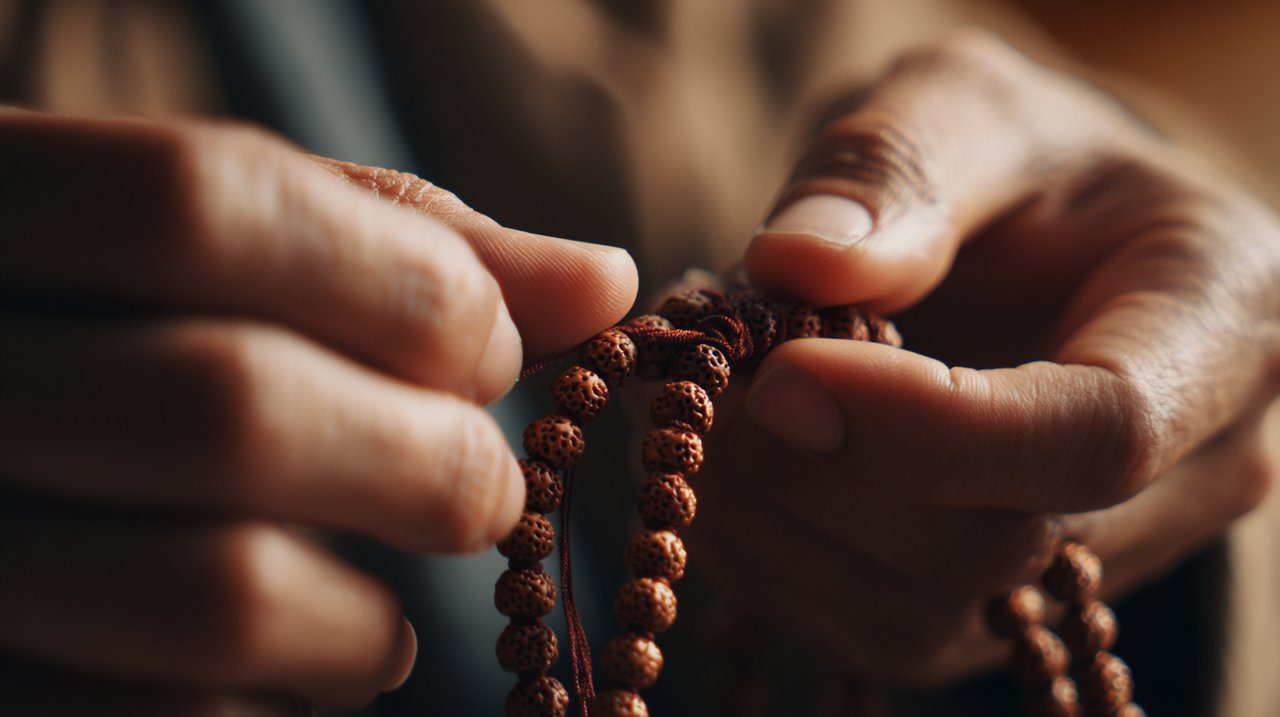My Bodhi Seed Mala Broke: Understanding Its Meaning and How to Re-string
Life, in its gentle unfolding, often presents us with moments that can shift our carefully held routines. For those of us who walk a path of mindfulness or meditation, the unexpected breakage of a cherished Bodhi seed mala can feel like one such moment—a sudden unraveling that might bring surprise, a touch of disappointment, or even a quiet sense of loss. Yet, what if this perceived disruption is truly an invitation to pause, to reflect, and to engage in a deeper practice? We can transform this unexpected event into a gentle micro-ritual of re-commitment and spiritual renewal. Together, we will explore not just the patient steps of how to re-string a mala, but also the quieter meanings behind its breaking, turning a moment of change into an opportunity for mindful restoration and a renewed connection to your inner path.
Before we delve deeper into transforming this unexpected event into a gentle micro-ritual of re-commitment and spiritual renewal, it’s worth noting that this article is part of our comprehensive guide to Bodhi seed malas. There, you can find a full range of resources and product selections on this topic.
The Whisper of Change: Understanding the Mala’s Gentle Release
When your Bodhi seed mala gently comes apart, it’s natural to feel a quiet pang of sadness, or perhaps even a flicker of worry. Yet, in many wisdom traditions, this event is often seen not as an unfortunate sign, but as a beautiful symbol of completion—a release of energies and intentions that have served their purpose. It suggests that your mala has fulfilled its role in its current form, having quietly absorbed countless prayers, intentions, and the gentle wear of dedicated use.

This perspective resonates deeply with the principle of impermanence, 「Anicca」, reminding us that nothing in life remains fixed or eternal. Consider how a tree gracefully sheds its leaves, preparing for the vibrant new growth of spring. In a similar way, your mala’s breakage can signify a natural transition, an invitation to gently release what was and to welcome what is yet to come. It’s a soft reminder to let go of attachment to the physical form and to embrace the continuous, flowing nature of change itself.
“All conditioned things are impermanent’ — when one sees this with wisdom, one turns away from suffering.” – The Buddha
Embracing the Pieces: A Moment for Quiet Reflection and Presence
Before you feel the urge to immediately repair your mala, let’s consider this a precious moment for mindful reflection and deep presence. Instead of seeing the scattered beads as an urgent task, approach them with a sense of reverence and gentle curiosity. This deliberate pause creates a quiet, sacred space, allowing you to simply observe any emotions that arise—without judgment, just noticing them.
Find a serene, clean space where you can gently gather each bead. As you hold each one, truly feel its unique texture, its coolness or warmth, and its subtle weight in your palm. Take a few slow, deep breaths, softly observing any thoughts that surface—perhaps a touch of disappointment, a flicker of surprise, or even a wave of gratitude for your mala’s long service.
This conscious act of collecting the pieces, rather than sweeping them away in haste, transforms the incident into a meaningful exercise in acceptance and gentle self-inquiry. It becomes an invitation to ask yourself, with kindness: What intentions have I been holding close? What might be ready for a gentle release in my own life?
Preparing for Renewal: Gathering Your Tools with Intention
The very act of preparing to re-string your mala is, in itself, a meditative prelude to renewal. Each item you gently gather becomes a cherished component of your personal ritual, chosen with thoughtful care and clear intention. This is far more than a simple repair; it’s the conscious, deliberate act of setting a tranquil stage for focused, mindful work.
Here are the tools you’ll need, along with a mindful approach to bringing them together:
- New Cord: Select a durable, strong cord, perhaps made of nylon or silk. Choose a color that quietly resonates with your current intentions or the qualities you wish to cultivate, recognizing the symbolic strength of this new thread.
- Fine Beading Needle: Find a needle thin enough to gracefully pass through the delicate opening of your Bodhi beads.
- Sharp Scissors: For clean, precise cuts.
- Jewelers’ Glue: A tiny, mindful drop can gently secure the final knots, symbolizing a firm yet fluid commitment to your renewed practice.
- Your Beads: Gather all your original Bodhi beads. If needed, take a moment to gently clean them. Remember, Bodhi seeds themselves carry a quiet energy, symbolizing the path to awakening.
- Guru Bead & Tassel: Take time to gently inspect your old guru bead and tassel. Do you feel drawn to reuse them, symbolizing continuity and the wisdom of your past journey? Or perhaps you’d prefer to replace them, signifying a fresh start? This choice, made with intention, can be a quiet reflection of your ongoing path.
- Clean Work Surface: Prepare a quiet, undisturbed area. Lay out a soft cloth—perhaps one with a calming texture—to prevent any beads from rolling away, thereby creating a peaceful sanctuary for your work.
The Art of Re-stringing: Weaving New Intentions with Each Bead
Now, with your tools gently gathered and your mind feeling clear, let’s engage in the physical act of re-stringing as a deliberate, meditative practice. This is truly where our 「micro-ritual of re-commitment」 comes to life. Each mindful knot you tie, each bead you patiently thread, becomes a quiet affirmation of your intentions—a tangible step in rebuilding and reaffirming your inner path.
Let’s follow these steps with patience and presence:
- Prepare the Cord: Gently cut an ample length of your new cord—perhaps twice your arm span—ensuring you have plenty for comfortable knotting and any adjustments.
- Thread the Beads Mindfully: Begin to thread your Bodhi beads, one by one, with focused attention. After each bead, tie a simple, secure knot. This traditional knotting serves a beautiful purpose: it helps space the beads evenly, offers a gentle safeguard should the cord ever come apart again, and most importantly, provides a sacred moment for conscious intention-setting with every single bead.
- Affirm Your Intentions: As you thread each bead and tie each knot, take a quiet moment to silently affirm an intention. This could be a quality you wish to cultivate, such as 「peace,」 「patience,」 or 「compassion.」 It might be a simple mantra, or perhaps just a gentle focus on your breath. Allow each knot to softly solidify this intention within you.
- Attach the Guru Bead and Tassel: Once all 108 beads are strung and knotted, carefully thread the cord through your guru bead and then secure the tassel. This final step completes the physical restoration, bringing your mala back into its complete, renewed form.

Remember to be patient with yourself throughout this process; it can be intricate and calls for your gentle focus. Rushing might lead to frustration or knots that don’t feel quite right. Allow yourself the time and the focused attention this sacred task truly deserves, transforming what might seem like a simple repair into a profound act of creation and inner dedication.
Activating Your Mala Anew: A Gentle Re-consecration of Purpose
With your mala lovingly re-strung, the final, beautiful step is to conclude this journey of renewal with a simple, personal ritual of re-consecration. This practice isn’t about imbuing the mala with an external power, but rather about re-aligning yourself with its renewed purpose and gently reaffirming your commitment to your practice.
- Hold Your Mala: Gently cup your newly re-strung mala in your hands. Take a moment to truly feel its weight, its smooth texture, and the familiar coolness of the Bodhi seeds against your skin. Close your eyes and take a few slow, deep, centering breaths, allowing your body to softly relax.
- Set New Intentions: Silently bring to mind the intentions you wish to dedicate to this mala moving forward. Perhaps it’s for deeper moments of meditation, for cultivating specific virtues, or for guiding a particular mantra practice. Gently visualize these intentions flowing from your heart, through your hands, and into the mala.
- Silent Dedication: You might offer a silent prayer, a personal dedication, or simply sit in quiet contemplation, allowing your energy and focused presence to flow into the mala. Recognize it not as an object holding inherent power, but as a cherished tool and a gentle, constant reminder for your own inner journey and practice.
This gentle re-consecration signifies a fresh start, a conscious recommitment to your path, and a quiet acknowledgment of the resilience found in embracing life’s natural cycles.
The breakage of a Bodhi seed mala, initially an unexpected event, can thus be transformed into a profound opportunity for mindful pause, quiet reflection, and intentional renewal. By gently engaging with its deeper meaning and mindfully undertaking this micro-ritual of re-commitment, we find that we don’t just repair an object; we deepen our connection to our practice and lovingly reaffirm our path.
This journey from a moment of disruption to mindful restoration reminds us that even within moments of gentle breakage, there lies an inherent opportunity for growth, quiet resilience, and a deeper, more present way of being. May your newly restored mala serve as a gentle, constant reminder of your inner strength and the continuous, beautiful unfolding of your mindful path.
💡 Frequently Asked Questions
In many wisdom traditions, the breaking of a Bodhi seed mala is viewed not as an unfortunate event, but as a symbol of completion and a release of energies and intentions that have served their purpose. It signifies that the mala has fulfilled its role in its current form and can be seen as an invitation to embrace impermanence and welcome new transitions, similar to a tree shedding leaves.
Before re-stringing, approach the scattered beads with reverence and gentle curiosity. Take a deliberate pause to observe any emotions that arise without judgment. Gather each bead mindfully, feeling its texture and weight, and take slow breaths to notice surfacing thoughts. This transforms the incident into an exercise in acceptance and self-inquiry, prompting reflection on held intentions and what might be ready for release.
To re-string a Bodhi seed mala, you will need new, durable cord (like nylon or silk), a fine beading needle, sharp scissors, jewelers' glue for securing knots, all the original Bodhi beads, and optionally, your original or new guru bead and tassel. A clean, quiet work surface with a soft cloth to prevent beads from rolling is also essential.
Tying a knot after each bead during the re-stringing process serves several purposes: it helps space the beads evenly, acts as a safeguard against future breakage, and most importantly, provides a sacred moment to consciously affirm an intention or mantra with every single bead. This practice turns the physical repair into a meditative act of intention-setting.
A 'micro-ritual of re-commitment' refers to the intentional process of re-stringing the mala and then performing a personal re-consecration. This involves holding the newly restored mala, setting new intentions for its use, and dedicating it through silent prayer or contemplation. It's a way to realign oneself with the mala's renewed purpose and reaffirm commitment to one's spiritual practice.








